AMD Ryzen 9 7950X

The AMD Ryzen 9 7950X is the vanguard for a whole new generation of CPUs and GPUs launching in these next few months. But, despite its many advances, a whole new AM5 motherboard platform, and shiny new heatspreader design, this isn't the best gaming CPU we were hoping for.
I mean, it's good. And certainly smashes the 16-core Ryzen 9 5950X from the Zen 3 generation, but this Zen 4 chip has a resurgent Intel CPU architecture to deal with in Alder Lake. And that's getting its own Raptor Lake update in the coming weeks, too.
But we've come a long way (baby), and it's been a steady road from the heady times of 2017, when AMD launched its very first AMD Ryzen processor. Closing the gap on Intel's performance lead was only part of the puzzle for its burgeoning line of Zen architectured CPUs; consistency was always the watchword. AMD knew then the long-term success of its new processor line, whether in our gaming PCs, laptops, or in datacentres the world over, was down to delivering on its promises generation after generation.
And it's hard to argue that AMD hasn't done exactly that in the years since its inception. Each successive CPU generation has built on those initial Zen foundations, confidently pushing the architecture to greater performance levels, and with more expansive specs lists. And it's done so on a regular cadence, pretty much exactly when and how it said it would.
Delivering on its promises is what's put AMD in the position it's in now—threatening Intel on all fronts. And, at a time when Intel has been struggling to deliver what it promised, that's cemented AMD's position.
The new Ryzen 9 7950X is an evolution of the Zen 3 design, and is at once a brute of a processor, running at the ragged edge of its thermal constraints, and yet with an impressively elegant design. Even on the outside.
Yeah, I'll say it, I love that new heatspreader look.
But it's still not the processor I'd pick up today and there's a chance it might get savaged out there for being more of a derivative than a revolutionary CPU. There's no spectacular new tech on display, no vertically bonded cache chips, no extra cores, just a healthy clock speed bump, some finessed microarchitecture, and a new socket.
Zen 4 architecture and spec
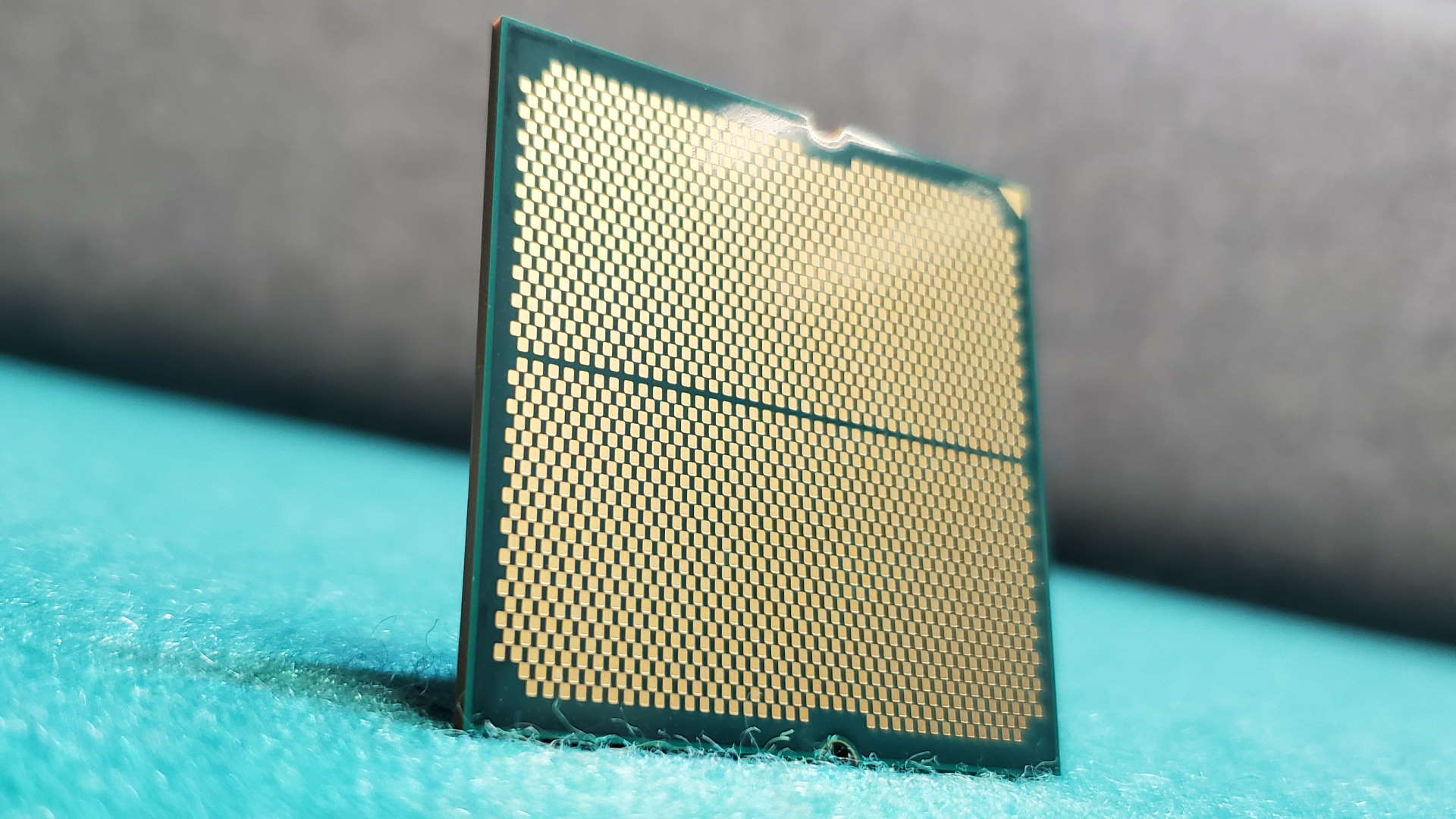
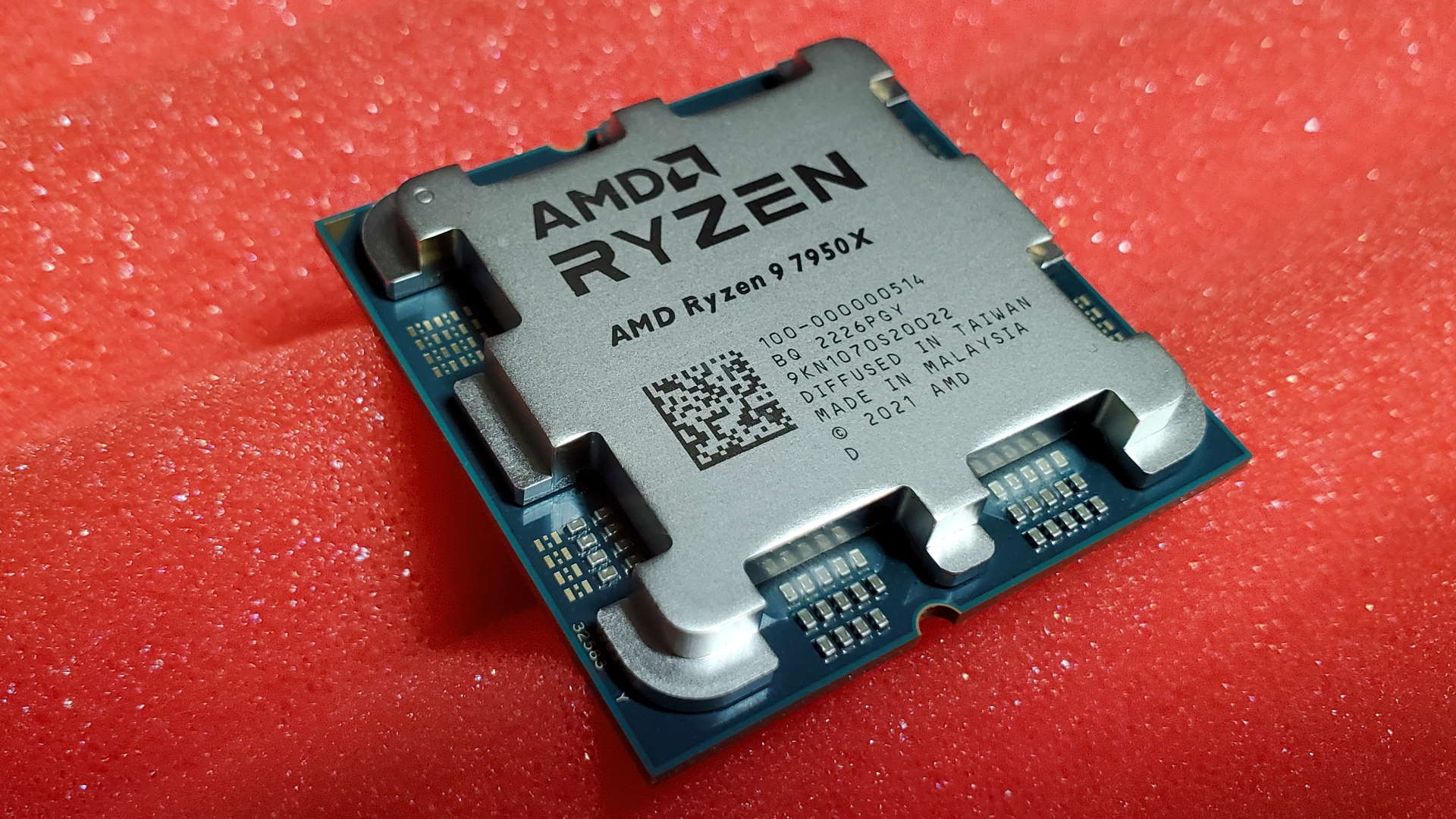
Cores: 16
Threads: 32
Socket: AMD AM5
CCD lithography: TSMC 5nm
CCD die size: 70mm²
CCD transistor count: 6.5 billion
IOD lithography: TSMC 6nm
IOD die size: 122mm²
IOD transistor count: 3.4 billion
Max boost clock: 5.7GHz
Base clock: 4.5GHz
L2 cache: 16MB
L3 cache: 64MB
Memory support: DDR5-5200 (non-OC)
TDP: 170W
Price: $699
At its most basic level, the Ryzen 9 7950X is a straight 16-core, 32-thread CPU, packing a pair of eight-core compute chiplets together with an I/O die to get all the data into and out of the processor package.
But though Zen 4 is a derivative architecture built from Zen 3, there are some fundamental differences. Firstly, it's built on a new process node from its long-time TSMC foundry partner. The eight-core chiplet (CCD) is built on the 5nm lithography while the I/O die (IOD) has shifted to a 6nm node.
The move from 7nm to 5nm may not be huge—though it is certainly delivering a more efficient chip on the whole—but going from the 12nm IOD of Zen 3 to a new 6nm version is. And arguably the biggest changes have actually been made in there at the platform level, rather than in the new Zen 4 CCD.
AMD has made the move to a DDR5 memory controller, and it's also popped PCIe 5.0 support in there too. That gives you the same fast memory as Intel's Alder Lake platform, but with a new generation interconnect that will offer huge bandwidth opportunities for future graphics cards and next-gen SSDs. Which won't be here until November, but hey, the new AM5 platform is ready at least.
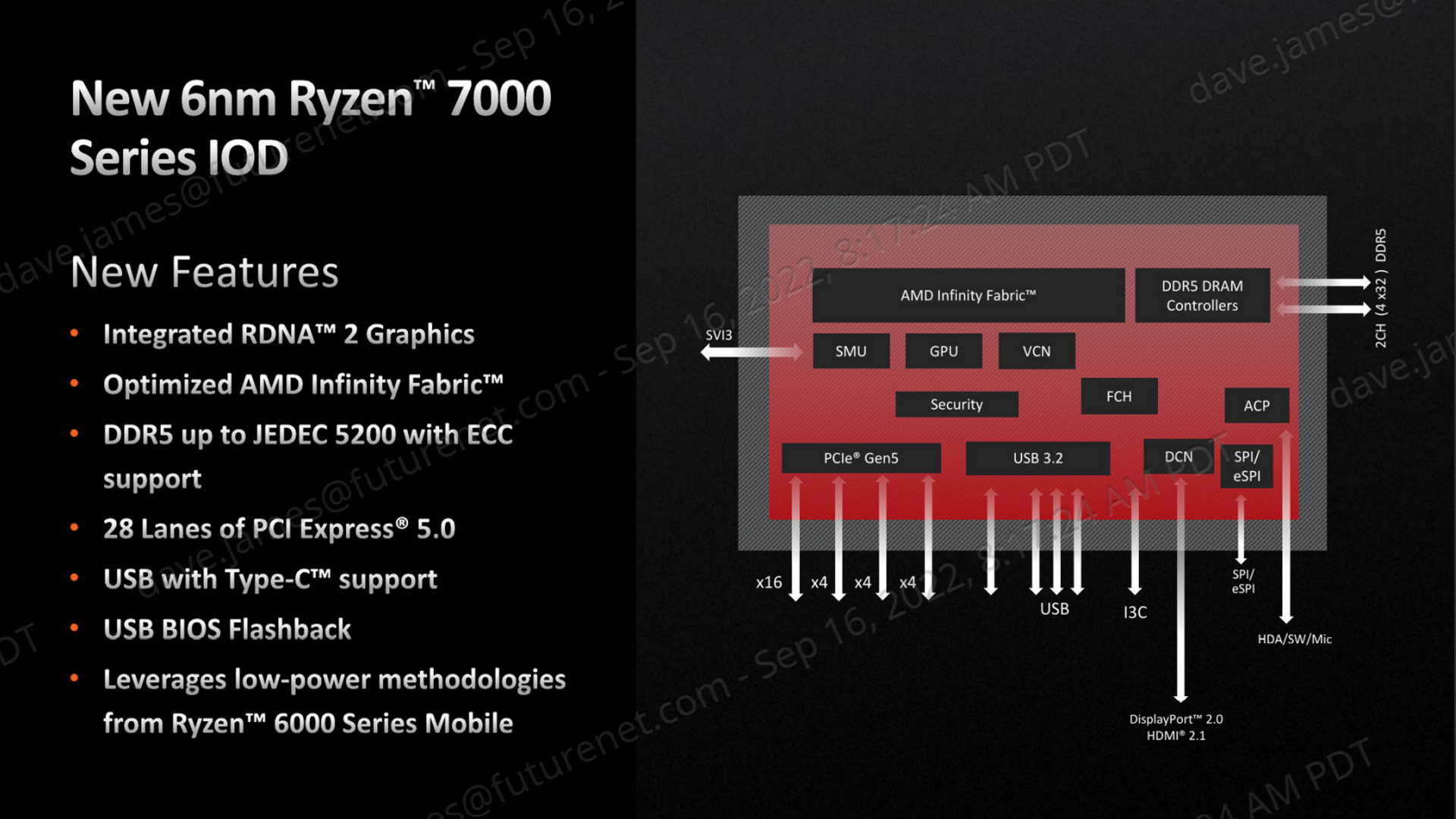
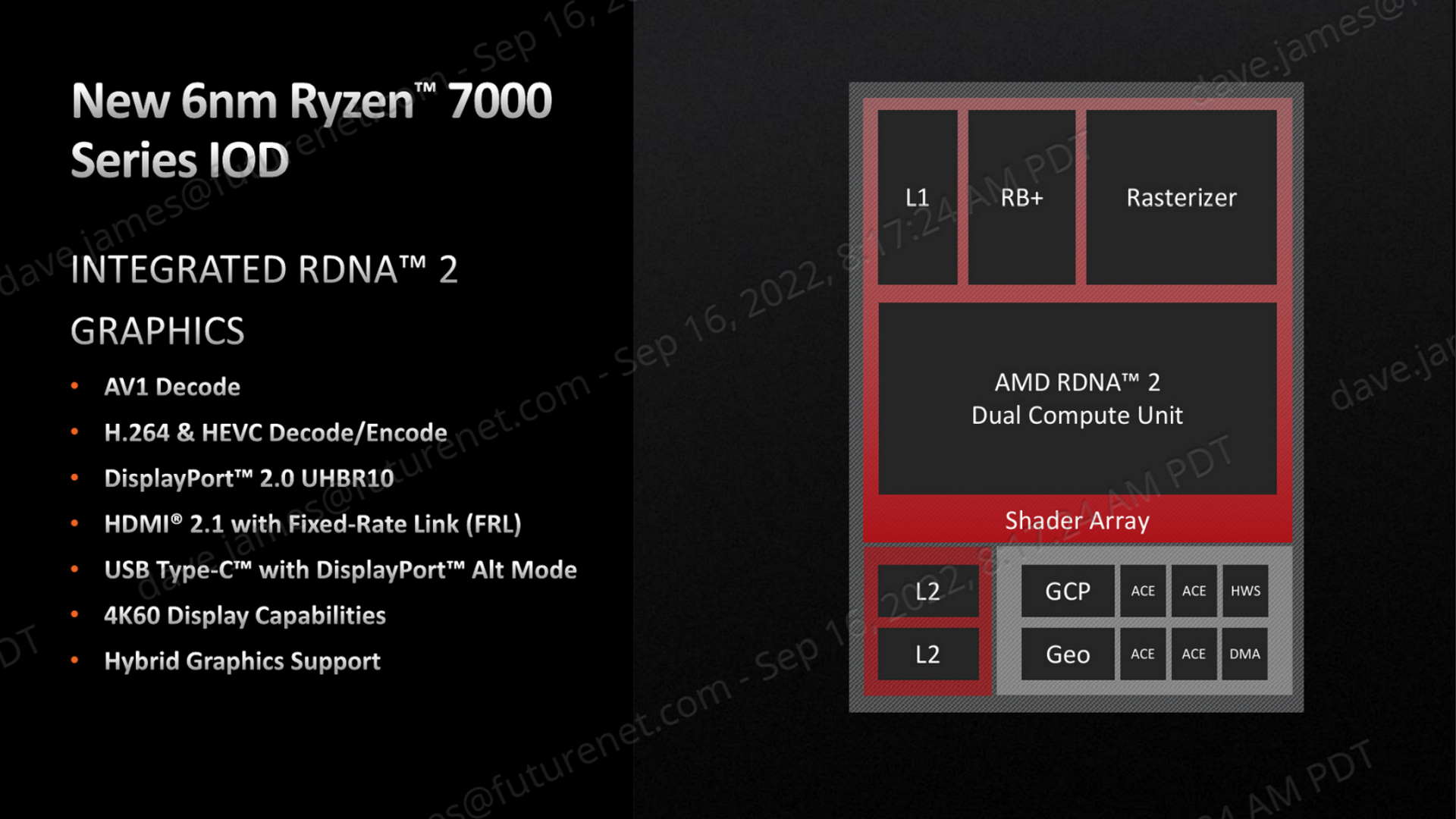
But, for the first time outside of its APU range, AMD is also packing integrated graphics into its chips, into the IOD. This is current-gen GPU technology dropping into all of its Ryzen 7000-series CPUs. Before you get too excited, however, AMD has been at pains to point out this is mostly just to keep the lights on for your monitor without a separate GPU. It's also there to help sell into the corporate Dell box world Intel has dominated because most companies don't want discrete graphics cards in their office systems.
It's too distracting for the workforce. Or something.
Whatever, there are a pair of RDNA 2 compute units in there, which don't even get to feature in the chip's reviewer's guide. It doesn't even appear on the essential specs list of any of the Ryzen 7000-series processors; it's that irrelevant outside the corpo world.
Unless your GPU dies, of course, and you need to get your PC up and running whether it can game or not, until you remortgage the kids so you can afford a new RTX 4090. But it does have one other potentially useful feature: Hybrid Graphics.
It's basically like a gaming laptop, where most of the time the display is actually connected to the CPU's integrated graphics, and the beefy discrete GPU only kicks in when a game is played or something else in need of graphics hardware. Yes, you can now plug directly into the motherboard and still game on your powerful graphics card.
As a PC gamer, you probably shouldn't do that, though, because it does have an impact on the gaming performance of your system. To an impressively negligible extent, I have to admit given what it's doing. At its very worst I saw a 10% drop at 1080p frame rates, but generally, it was around 3–5% down. That's not bad, but still not really worth it if you're chasing the highest frame rate you can squeeze out of your gaming rig.


Over in that 5nm CCD, there have been some other changes made. It's essentially the same core layout as Zen 3, with the same 32MB L3 cache catering to an eight-core complex. To get to its 16-core makeup the Ryzen 9 7950X comes with a pair of those compute dies, each holding eight cores and a total of 64MB of L3 cache. But there's a doubling of the L2 cache to help reduce overall latency with each core getting its own 1MB L2 "to provide critical data faster," says AMD's Mark Papermaster during our introduction to the architecture.
Though this extra cache bump is not in the same league as the recent Ryzen 7 5800X3D, but we'll come back to the future of 3D V-cache later on. As will AMD itself; there's a reason there's no Ryzen 9 7800X in the launch lineup.
"With Zen 3 we increased the execution width," Papermaster tells us. "And so with Zen 4 it became important for us to work on how we feed the instructions even faster into the machine. And that's why you see most of the improvements coming from the front end and branch prediction. Really that makes up almost 60% of that IPC gain."
That's echoed by AMD architect Mike Clark, the father of Zen, during our deep dive.
"With Zen 4 as slightly a derivative architecture, we knew that with Zen 3 we really increased the execution side, added a couple more execution units. But we knew with Zen 4 we need to be able to feed those things as fast as possible to really get the benefit of the new wider engine that we have."
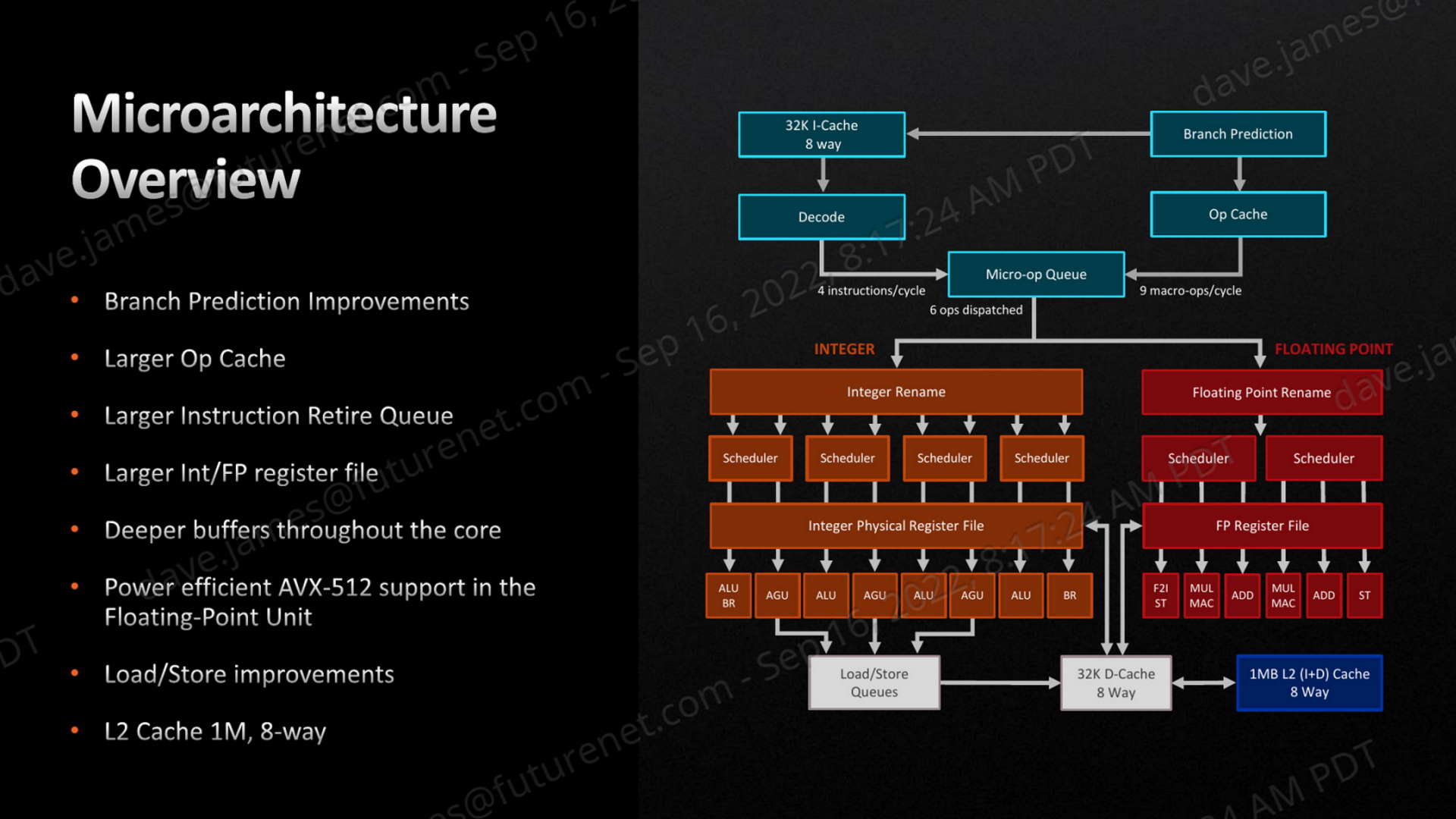
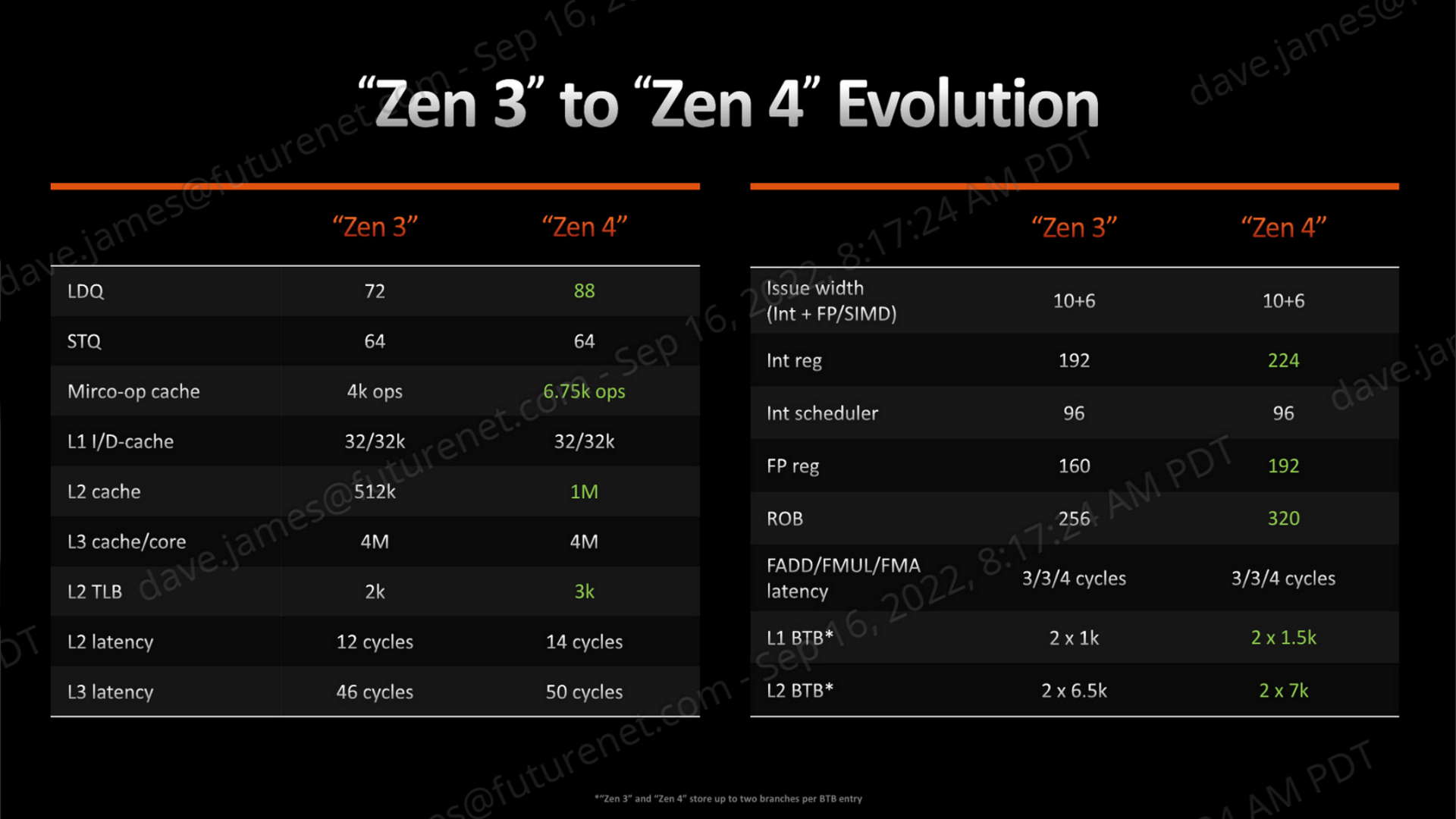
So, it's the front end of the Zen 4 architecture where AMD has put the most thought in from a core design perspective. And that starts with the branch prediction block, because that's where a lot of the efficiency and performance of a chip design can be won or lost.
"One of the most inefficient things," says Clark, "is obviously executing the wrong instructions, and then having to throw that away. So we want to make sure we're on the right path, as well as getting that right path in the machine as fast as possible"
In microarchitecture terms, it's basically all about widening the funnel at the top, while also jamming more data down into the integer and floating point execution machine. That's my dumb way of saying AMD is looking to widen any of the bottlenecks of the Zen 3 design.
The trade-off with increasing the cache, however, is an increase in latency, but that's something AMD has internalised as part of its design process with Zen 4. The latency has still gone up, but the fact that it can get more instructions running through the processor at any one time, and with the overall performance improvements the architecture then offers, that will offset what it's calling "a small increase in latency."
How does the Ryzen 9 7950X perform?


I mean, it is certainly fast. I did a bit of a double take checking out the numbers when I saw the Cinebench R23 single thread run tipping the odd core up to 5.9GHz. Even stable at 5.8GHz was pretty shocking. It's not quite that high under all-core load, but 5.4GHz across all 16 cores still makes it one blazing chip.
It's blazing in another way, too, because damn, does this thing get hot?! Actually, no. It's okay. AMD says that "At 95 degrees it is not running hot, rather it will intentionally go to this temperature as much as possible under load because the power management system knows that this is the ideal way to squeeze the most performance out of the chip without damaging it."
Apparently, the Ryzen 7000-series processors are designed to run at this level "24/7 without risk of damage or deterioration."
But does fast and hot make it the ultimate gaming processor? Not really, not at all in fact. On that score, it will often get outperformed by the eight-core Ryzen 7 7700X which launches alongside it. It is comfortably faster than the previous generation's Ryzen 9 5950X, which is important, especially as that was priced some $100 higher on release.
It also regularly outpaces the Ryzen 7 5800X3D, which was AMD's most recent play for the fastest gaming CPU crown. But against Intel… well, the Core i9 12900K is still looking like an outstanding gaming processor.
Gaming performance
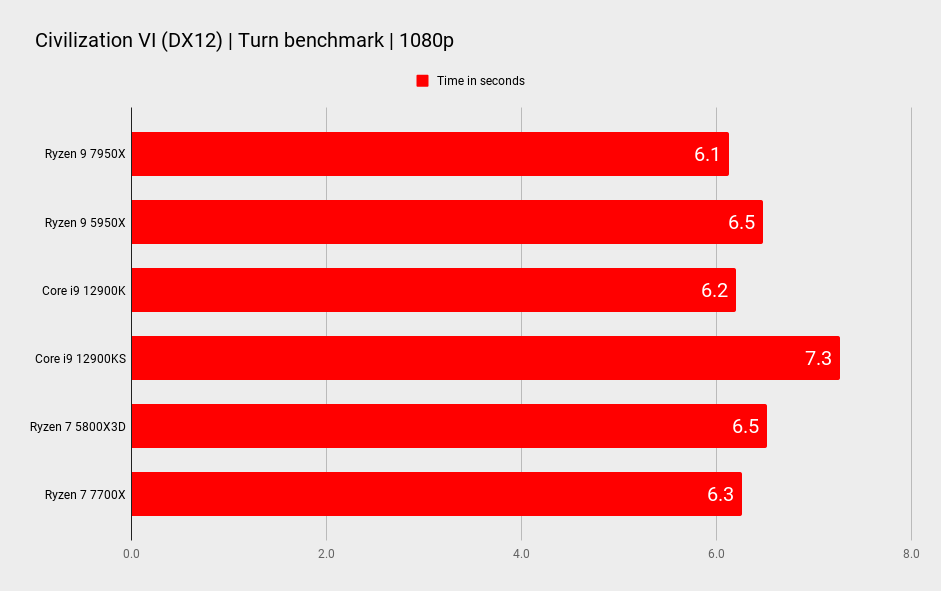
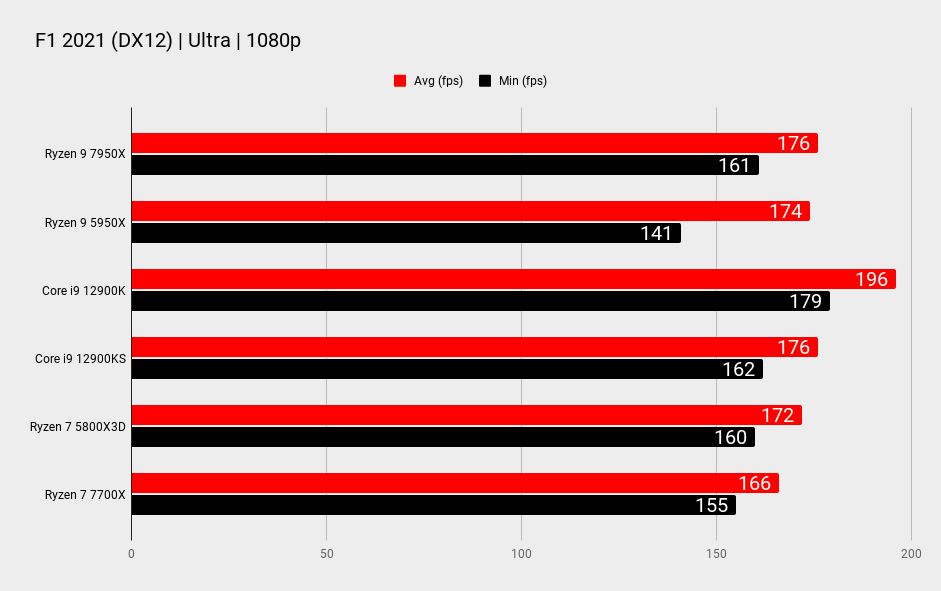

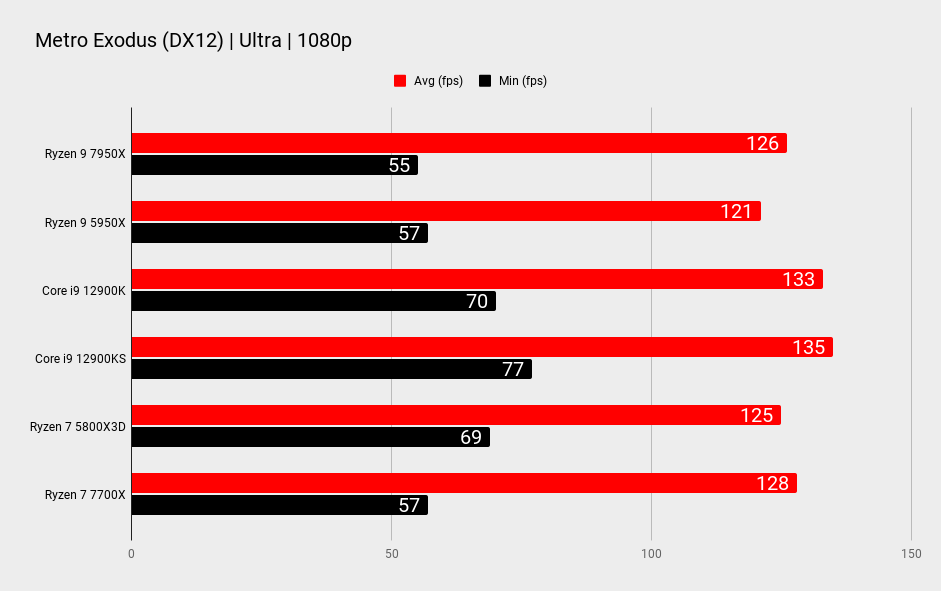
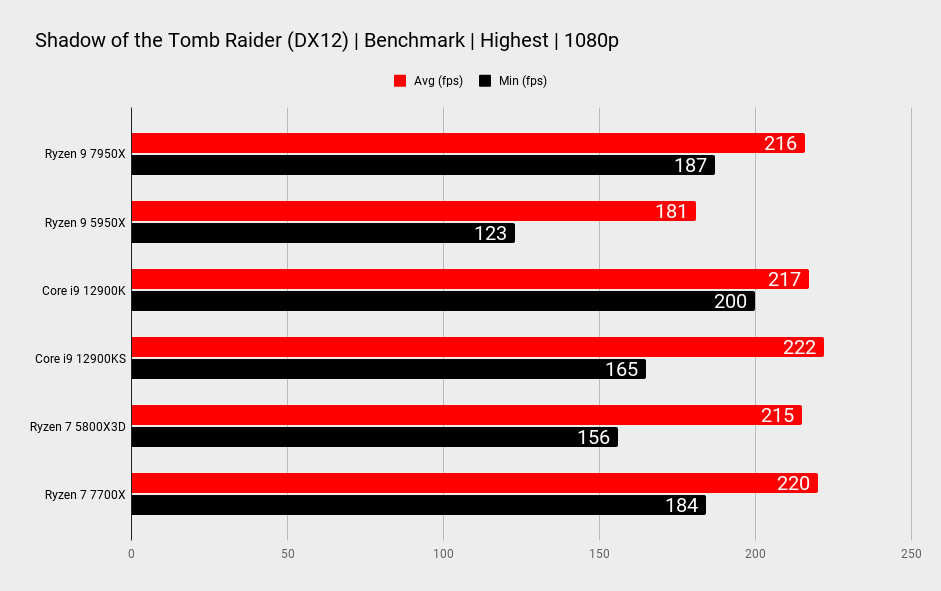

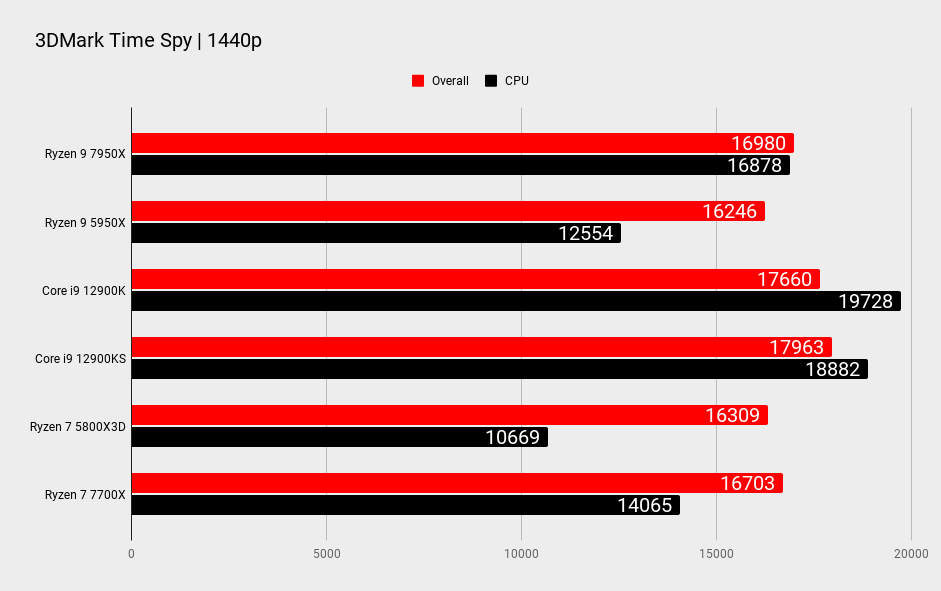
In gaming terms, with the exact same GPU, the same drivers, and the same OS, Intel's Core i9 12900K keeps itself ahead of this, AMD's latest chip. The chip it's been calling "the best for gamers and creators."
There isn't a game in our test suite which has the new Zen 4 chip ahead of Intel's Alder Lake CPU. Which doesn't make for great reading when you consider that it will soon be replaced by an even speedier Raptor Lake range of processors that could push gaming performance even further ahead of AMD's chips.
Creator performance
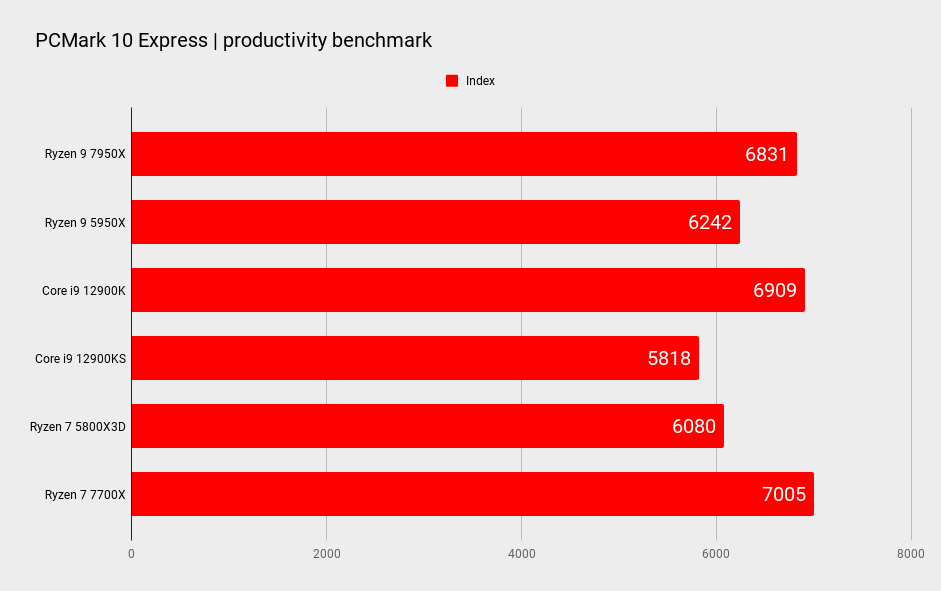


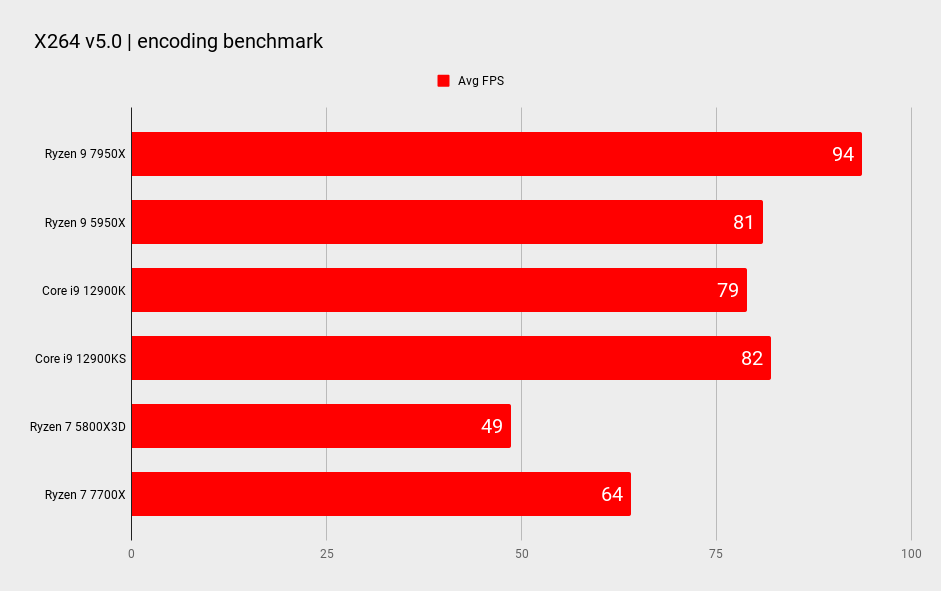

On the multi-threaded side, however, AMD's high-speed advantage comes to the fore. Seriously, I'll take that 95°C temperature if I can have all 16 cores operating at 5.4GHz for the duration. That makes all the difference when it comes to things like rendering and encoding, and AMD's dominance is clear to see.
In the Blender render test, the Ryzen 9 7950X is over 50% faster than the Core i9 12900K, and over 40% faster than the Zen 3-based Ryzen 9 5950X. That highlights just what a multi-threaded monster the new Zen 4 platform can create, and is really where all those front-end improvements really come to the fore.
It's the marriage of brute-forcing the clock speed and the elegance of those microarchitecture tweaks that deliver a processor that can be the basis of a powerful home workstation.
I mean, there's a reason the high-end desktop (HEDT) CPU market is dead; those old Intel Core X chips, and even AMD's own Threadripper. They don't appear on the PC roadmap outside of the professional space these days. And that's because AMD gambled on higher core counts and then again on an innovative chiplet design that has been one of the biggest success stories in modern processor creation.
But you don't need a Threadripper chip when the new Ryzen 9 7950X rocks up with 16 cores of Zen 4 grunt and will comfortably push each one of them to 5.4GHz for a fraction of its price. There are few bedroom videographers or renderers who wouldn't be enthusiastic about the performance of this chip and would argue paying another $1,700 for a 24-core Threadripper Pro makes any kind of sense.
The new AM5 platform's penchant for the number five is demonstrated by the increase in memory bandwidth owing to the support for DDR5 memory. With the new EXPO memory profiles tailored for both DDR5 and AMD's new platform, we could instantly hit the top frequency with our G.Skill DDR5-6000 kit. That delivers an easy 68% increase in memory bandwidth over the previous Zen 3 generation.
The benefits of the PCIe 5 interface, however, won't manifest until we get hold of some solid state storage drives maxing out the increased bandwidth when they arrive in November.
It's interesting to note, though, that while our AMD system is running with 32GB of DDR5-6000, our Intel Alder Lake machine is slumming it with another G.Skill set, but a 32GB kit running at DDR5-5600. And it still offers higher memory bandwidth.
System performance
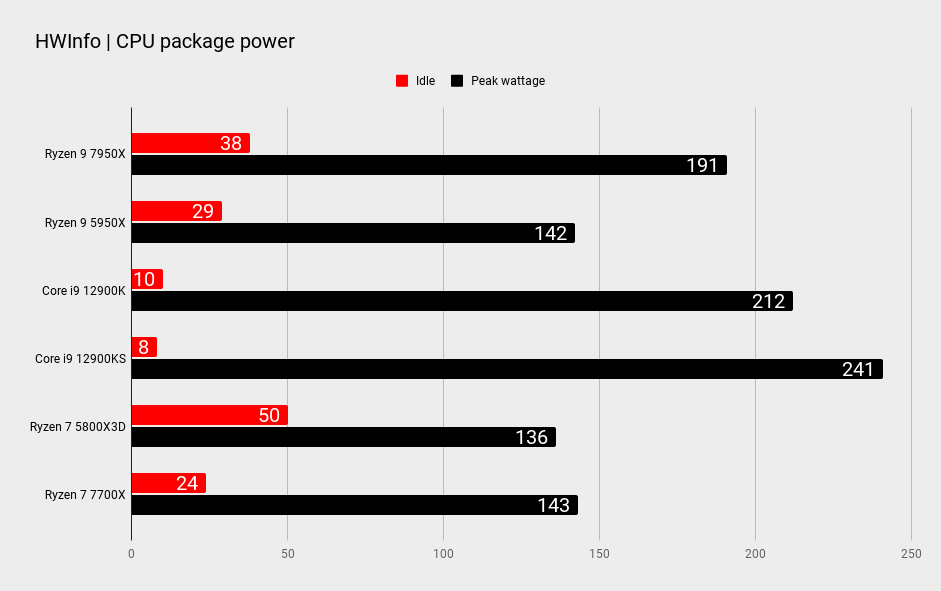


But what of efficiency? That was the watchword around the switch to Zen 4 and a 5nm CCD, but the Ryzen 9 7950X has a TDP of 170W and a max socket power of 230W. Even the Ryzen 5 7600X has a high TDP of 105W as opposed to the previous gen at 65W.
But the performance per watt of Zen 4 is impressive, especially when it comes to gaming. Measured in Far Cry 6 we're getting 1.61fps per watt of power, compared with less than 1fps per watt with the old Ryzen 9 5950X. It's also a lot cooler when you're talking about consistent gaming workloads.
Sure, under a 100% all-core load the Zen 4 cores are solid at over 95°C, but in games, we measured it at just 65°C.
What's interesting, however, is that for all the talk of Intel's desperate power demands making its chips power hungry and inefficient, the Core i9 12900K is both better in terms of performance per watt and thermals.
You can take the shackles off Intel's chips, and allow them to use all the power in your motherboard's BIOS, but if you stick to Intel's own specifications they won't stretch to the same levels. Okay, it will still top the 200W point when thrashing through Cinebench R23, but in games, you're looking at 81W and 50°C—lower than this 5nm Ryzen chip.
Eco Mode performance
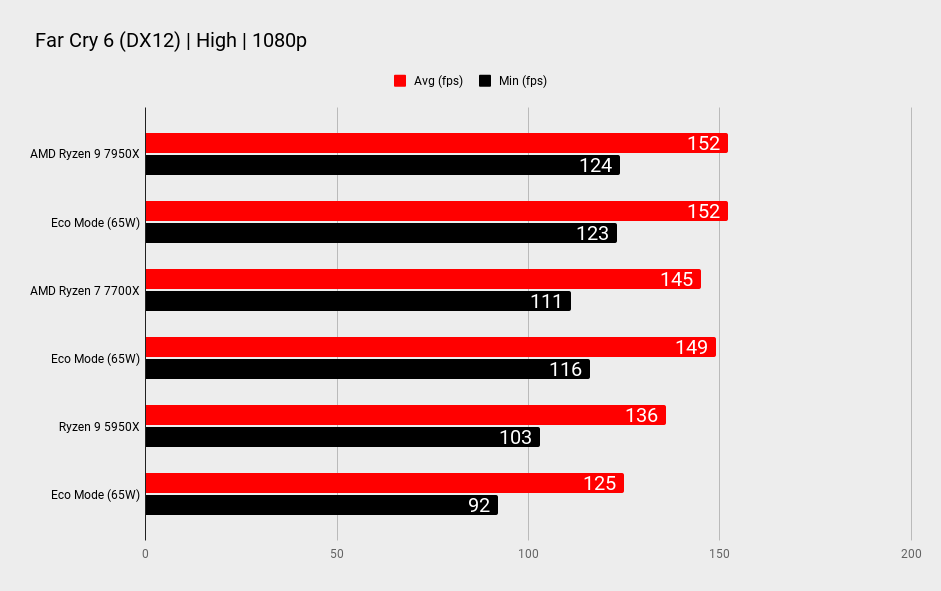

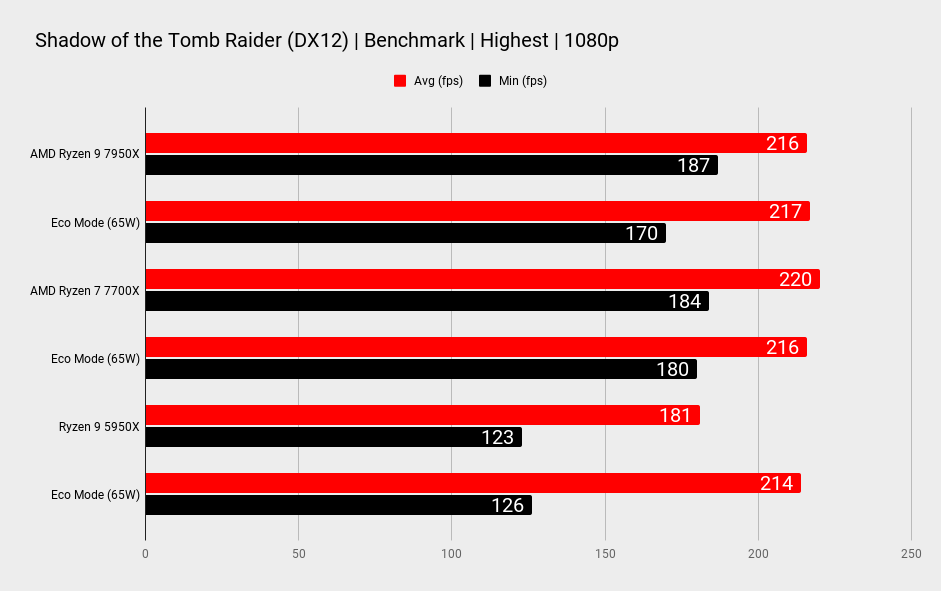
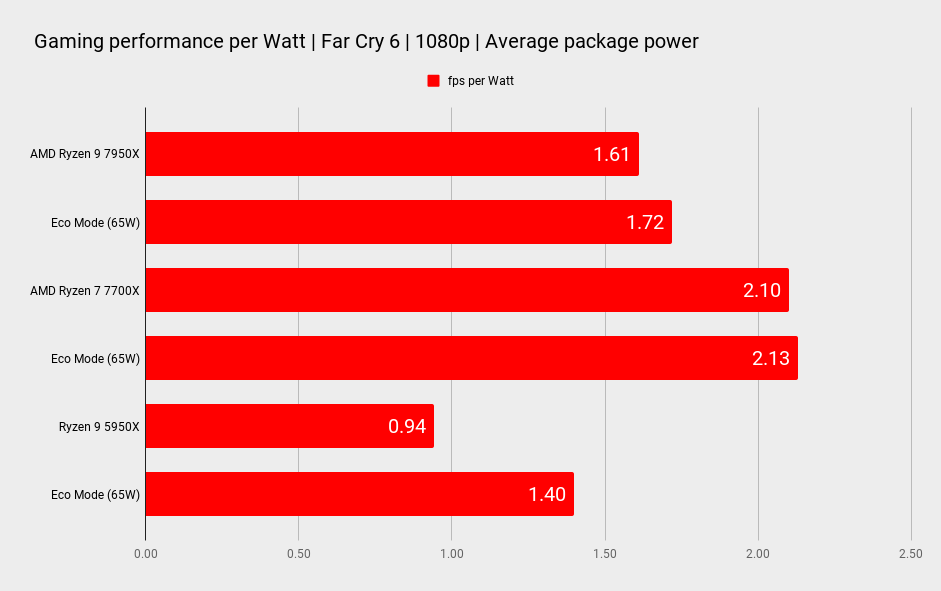
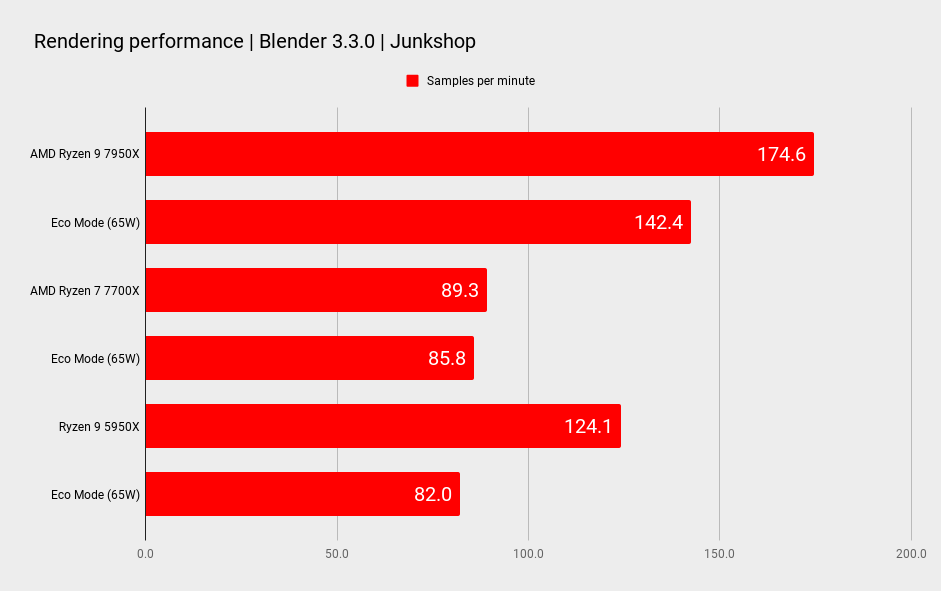
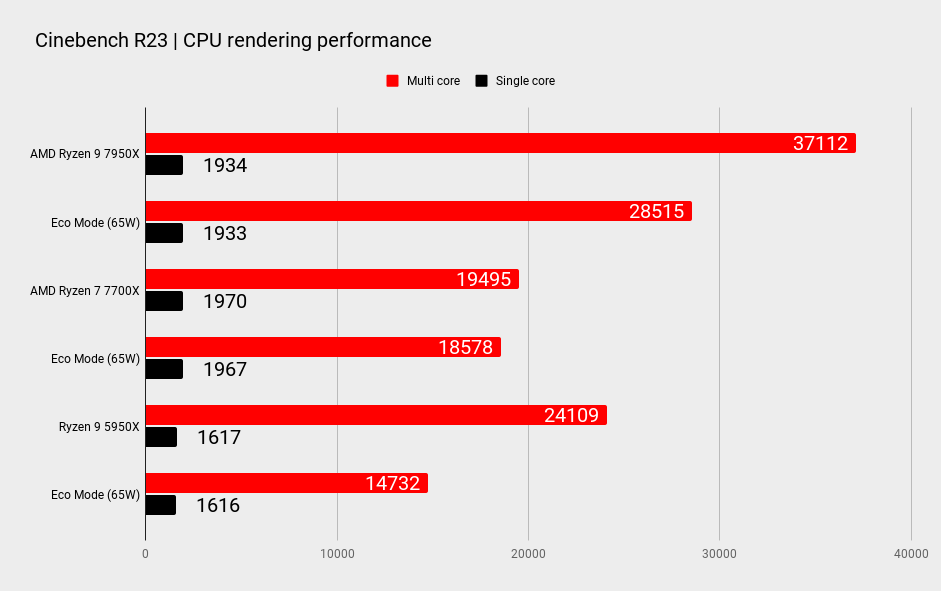
AMD
Motherboard: ASRock X670E Taichi
Memory: G.Skill Trident Z5 Neo DDR5-6000 CL30 2x 16GB
Intel
Motherboard: Asus ROG Z690 Hero
Memory: G.Skill Trident Z5 RGB DDR5-5600 CL36 2x 16GB
Graphics card: Nvidia RTX 3080 10GB
Storage: 1TB WD Black SN850
Cooler: Corsair H100i RGB
PSU: NZXT 850W
Chassis: DimasTech Mini V2
Even in Eco Mode, the Ryzen 9 7950X can't bring its performance per watt up to the levels of the Alder Lake chip. But Eco Mode is still one of the biggest wins for the new Zen 4 cores. The performance boost going from 7nm to 5nm is at its greatest at the 65W level, and that is highlighted by just how much faster the Zen 4 chip is, even locked to 65W, compared with the Ryzen 9 5950X.
In Eco Mode, it will also still beat the Core i9 12900K in creative applications, too.
Honestly, if I'm running a Zen 4 chip in my rig, I'm going to be setting it to Eco Mode all the time. You don't need the extra multi-threading performance for most of the time you use your PC, and when you do, just swap it out of Eco Mode and let those cores fly. You barely lose any performance while gaming—especially not at the 1440p or 4K resolutions—and the lower temps will make for a quieter rig, too.
Admittedly at the moment that's not so easy. In the pre-release BIOSes you have to dig around in the AMD Overclocking settings to manually set PPT limits, etc. but AMD is promising to make it a more accessible feature on your Windows desktop after launch.
I hope it does, because Eco Mode is one of the things which sets the Zen chips apart, and it's better than ever.
How does the Ryzen 9 7950X stack up?

Where does the new Zen 4 flagship chip stand in the CPU market? Today, it's the best chip for creators, and maybe even the best chip for creators who also game. But it's certainly not the best gaming CPU.
This $700 16-core processor, despite its heady 5.8GHz clock speed, still falls behind Intel's slightly cheaper Core i9 12900K when it comes to raw frame rates. And you can still get the GPU-less KF version of that Alder Lake CPU for much less than that. Though given that Raptor Lake is on its way very soon I'd not recommend that purchase right now, either.
But the multicore performance is pretty staggering. If you want to throw a ton of complex computational tasks at a client platform, say for video rendering or encoding, then there is nothing out there in this price bracket that can come close to the processing prowess of AMD's new Zen 4 top chip.
Its last-gen flagship suddenly looks very old indeed.
That's true even if you limit the Ryzen 9 7950X to just 65W. I think Eco Mode is the thing that has impressed me most about the new architecture, showing just how efficient it can be. Unfortunately, to be competitive with Intel's Alder Lake, AMD has had to go all out on the power and thermals by default to give its Zen 4 cores enough headroom to perform at their best.
And the raw clock speed numbers are spectacular, too. I mean, hitting 5.8GHz stock, out of the box is something I don't think many of us were really expecting.
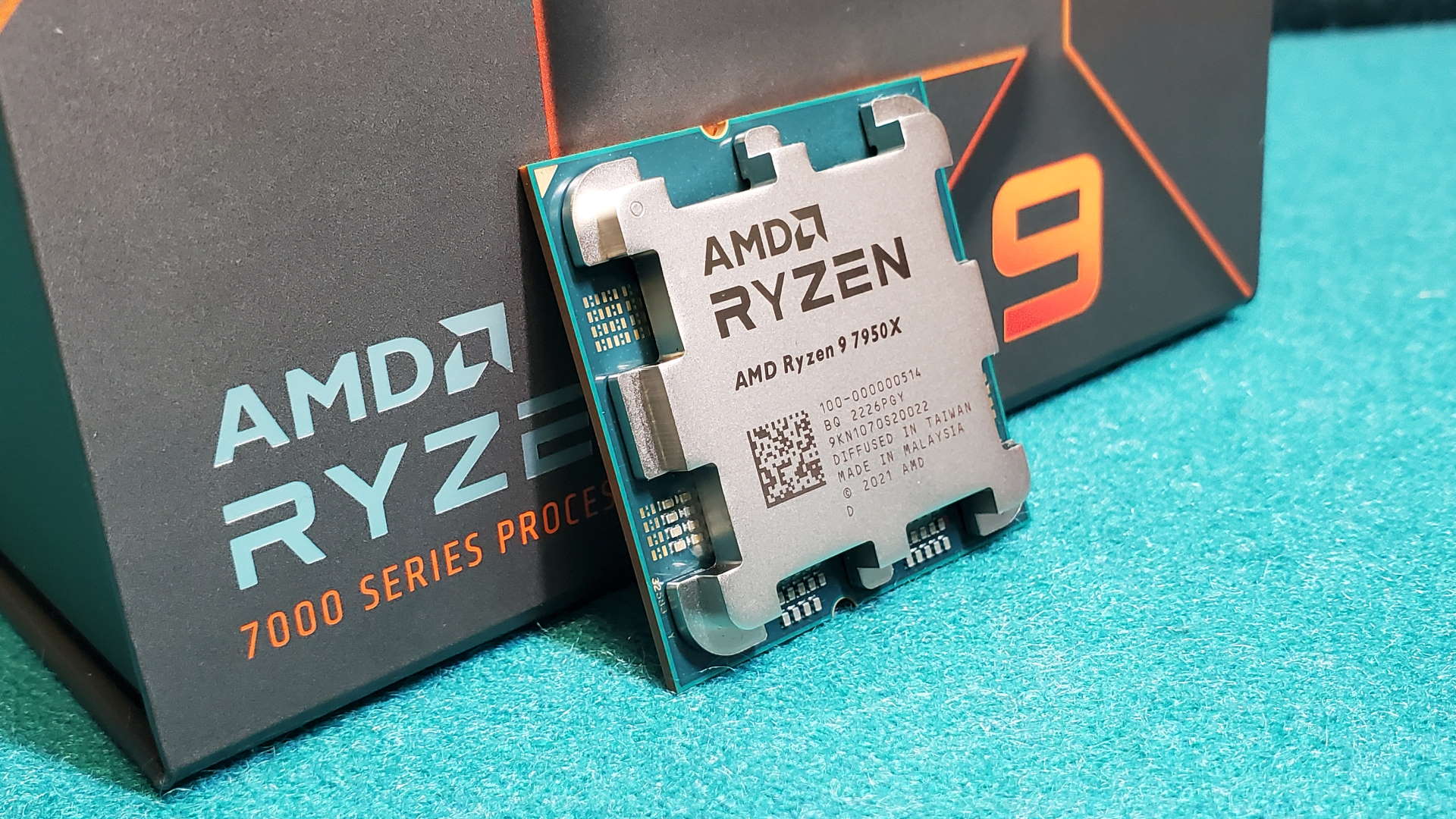

I've been testing the eight-core Ryzen 7 7700X alongside this 16-core chip, and that is a performance gaming chip that will sometimes even beat the Ryzen 9 7950X. But it, too, is shy of the Alder Lake competition in raw frame rates, though can at least match it in terms of performance per watt.
Though if we're talking about AMD gaming CPUs, there is a big, flappy-eared grey mammal in the room. There's no Ryzen 7 7800X in the launch lineup, and that feels like a gap tailor-made for a cached-out X3D chip, along the lines of the Ryzen 7 5800X3D, to pop into. With a vast chunk of extra L3 cache to play with, the 3D V-cache design is made for gaming, and that should be AMD's real play for the best gaming CPU. Though when that launches, we still don't know.
AMD has been very cagey about its plans, initially suggesting it would be released this year and now we're not so sure. Joe Macri told us that "we're not trying to dribble things out to you, the cycle time of running stuff through the fab just takes longer when you want to take two pieces of silicon and literally fuse them together at the molecular level."
Until it's got those big cache chips bonded onto the CPU we're going to have to wait and see what extra gaming impact the expanded L3 cache can have alongside a Zen 4 core.
Ryzen 9 7950X verdict


I feel quite positive about AMD's top Zen 4 processor, which is maybe a little strange given that it's more evolution than revolution and doesn't quite have the standout performance leaps that characterised the previous generations of Zen chips.
But I think we've probably been spoiled by AMD in recent times.
The Ryzen 9 7950X is still a big generational jump over the Ryzen 9 5950X, but it hasn't managed a convincing showing against its main Intel rival. That's especially true in gaming, and while the multi-threaded performance is pretty spectacular, we're in a position where we know Intel's bumping that up with its incoming Raptor Lake chips and that could entirely negate the improvements AMD has managed to muster for Zen 4.
Inevitably then you will likely see a lot made about it being a disappointing release. But, to me, it feels like a confident, consistent release. You could argue it's maybe not super ambitious, but AMD has got where it is today by always delivering on its Zen promises, and yet again Dr. Su's gang has absolutely done that.
The Ryzen 9 7950X is the fastest, hottest, most power-hungry Zen chip yet, but though it's not the gaming champ it is still the best all-round AMD CPU.